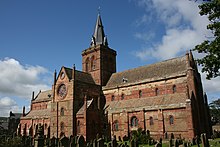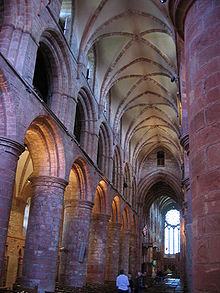St. Magnus Cathedral
The St Magnus Cathedral is the cathedral of the city of Kirkwall on Orkney in Scotland . The cathedral is dedicated to St. Magnus . It houses the remains of the saint. The cathedral is known as "The Light of the North".
history
In 1137 the St. Magnus Cathedral was donated by Count Rognvald-Kali. He was a nephew of St. Magnus . Before the Reformation , the cathedral belonged to the Archdiocese of Trondheim. In 1468 Orkney became part of the Scottish Kingdom. In 1486 the cathedral was given to the residents of Kirkwall.
In the course of the Reformation in Scotland , worship at the cathedral was reformed in 1560. But, unlike in many churches on the Scottish mainland, there was no iconoclasm . Henceforth, until 1688, St. Magnus Cathedral was the episcopal church of the Church of Scotland . After the episcopal-minded bishop left his office in 1688, the cathedral became a Presbyterian church. Today the cathedral is used by the Church of Scotland.
Renovations took place in the 1850s and between 1900 and 1925. During these years a new floor, the windows and the crossing tower were added. In the 1970s, the cathedral was stabilized as it sagged slightly to the west.
architecture
The oldest parts of the cathedral are the transept, the choir and the east side of the central nave. The cathedral was built in a style mix of northwest European, Romanesque-Norman and early Gothic styles. The east side closed in an apse in the 12th century . Only speculations are known about the western building. A double-towered facade is said to have been planned in the 13th century. To the west are the youngest parts of the cathedral.
Inner
The central nave is characterized by the massive columns in the Norman style. The side aisles are characterized by tombstones from the 17th century. The high choir was consecrated in the 1960s to the cathedral's founder, St. Rognvald. In the high choir there is also a memorial to the arctic explorer John Rae . The crossing is dominated by early Gothic columns. These pillars support the tower.
organ
The organ was built in 1926 by the organ builder Henry Willis & Sons in an organ front designed by George Mackie Watson . In 1969 the instrument was reorganized and the choir organ redesigned as a positive work for the main organ. Today the instrument has 42 registers on three manuals and a pedal .
|
|
|
|
||||||||||||||||||||||||||||||||||||||||||||||||||||||||||||||||||||||||||||||||||||||||||||||||||||||||||||||||||||||||||||||||||||||||||||||||
Web links
- St. Magnus Cathedral
- Orkney Heritage Website ( April 6, 2010 memento on the Internet Archive )
Individual evidence
- ^ Gordon Donaldson: Bishop Adam Bothwell and the Reformation in Orkney. In: Records of the Scottish Church History Society. Vol. 13, 1959, ISSN 0264-5572 , pp. 85-100, here p. 96 .
- ↑ More information about the organ
Coordinates: 58 ° 58 ′ 56 " N , 2 ° 57 ′ 32" W.



